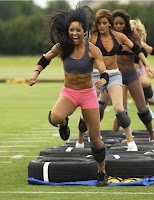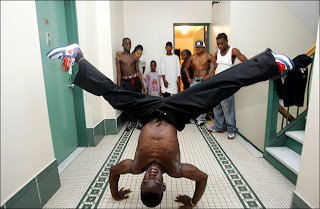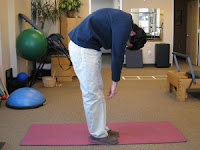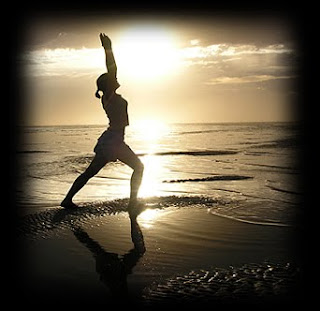 We often hear we are all one, but in which way are we so? Have you ever considered it? Clearly, we are all human, but within the physical domain we are assured, through genetics, an infinite variety. How then are we the same? Well, in actuality we are all the same, and it is to this sameness that great spiritual teachers have, throughout history, attempted to awaken us.
We often hear we are all one, but in which way are we so? Have you ever considered it? Clearly, we are all human, but within the physical domain we are assured, through genetics, an infinite variety. How then are we the same? Well, in actuality we are all the same, and it is to this sameness that great spiritual teachers have, throughout history, attempted to awaken us.
The material world is born of variety – different elements, different rock and metal composition, different phases of matter, different life forms, different species, and different environments. Every species has morphological and behavioral differences as well, which are only compounded by their relation to the environment. So between genetics and natural selection, then, the magnitude of variety is endless. For the human life form, there are also mental, emotional, and spiritual differences, that shape the temperament of the individual, as well as cultural and socioeconomic factors which act as strong influencers. Every distinct component of an individual leads to that person’s many-ness – their gender, race, national origin, sexual preference, personal style, musical taste, and palate to name but a few. Every person is unique and distinct when taking into account each difference that makes up that individual’s nuances.
On some levels, human beings celebrate differences. Most people want to be recognized and loved for “who” they are, their unique selves. While one may be proud of one’s heritage, one’s hometown, or one’s alma mater, most people want to be seen and appreciated for their authentic selves. As a result of this ubiquitous human drive, it is only natural for people to attach to the blueprint of their nuances – that is, to believe that their unique composition of differences is what makes them them. People attach to their personas to such a degree that if one or the other gets disrupted, the individual might fall victim to an identity crisis. Loss of job, death of a loved one, relationship changes are only a few of the great many changes that routinely disrupt people’s lives.
 But great spiritual wisdom teaches that none of these different elements are the actual us. Underneath lies something else, the true fabric of our authentic selves. This something else is precisely what the great sages claimed makes every living being the same in essence: an endless light, spark or spirit which sits underneath all those things we assume make us the psycho-spiritual-material entities we are. Not even the mind – our thoughts, perceptions, or emotions – are us. These things, too, come and go, so they cannot be our true selves by their sheer transience. The actuality of our essence is said to be eternal – existing before the current material form was born, and long after it will burn out – to either merge with the Absolute oneness (God, Tao, The Absolute, or Plotinus’ The One) or to inhabit a new life form, over and over again (samsara), until the final yoking (Yoga) of individual essence (Atman) with the absolute reality (Brahman). So the goal of Yoga, then, is to realize this individual essence through devotion (to Self-realization), duty* (dharma or purpose) and/or right discrimination (jnana or knowledge).
But great spiritual wisdom teaches that none of these different elements are the actual us. Underneath lies something else, the true fabric of our authentic selves. This something else is precisely what the great sages claimed makes every living being the same in essence: an endless light, spark or spirit which sits underneath all those things we assume make us the psycho-spiritual-material entities we are. Not even the mind – our thoughts, perceptions, or emotions – are us. These things, too, come and go, so they cannot be our true selves by their sheer transience. The actuality of our essence is said to be eternal – existing before the current material form was born, and long after it will burn out – to either merge with the Absolute oneness (God, Tao, The Absolute, or Plotinus’ The One) or to inhabit a new life form, over and over again (samsara), until the final yoking (Yoga) of individual essence (Atman) with the absolute reality (Brahman). So the goal of Yoga, then, is to realize this individual essence through devotion (to Self-realization), duty* (dharma or purpose) and/or right discrimination (jnana or knowledge).
*Which includes action (karma)
But devotion, duty, and right discrimination are not the tools most often employed by the masses, even though the Bhagavad Gita stresses them (not enough people have taken the time to read/study the Gita). The tool most often associated with awareness of the Self is meditation. Now, let it be said that Self-realization is virtually impossible without devotion, dedication to duty and knowledge. Nonetheless, meditation is effective in bringing our consciousness in tune with our essence from a physical, mental, and conceptual standpoint. It may sound counter-intuitive to more discerning minds as to how we might tune-in to our true essence with machinery (our brains and minds) that I have already pointed out is NOT what we are in actuality; but if we consider which layers of awareness are available to us – sensory/motor, consciousness, and essence – in order of decreasing complexity and refinement, we can see how we must peel off each successive layer of attachment (or what some might call illusion –maya), from what we sense (see, hear, touch, smell, taste), feel or think…the forms of awareness we most generally use to distinguish self from other.
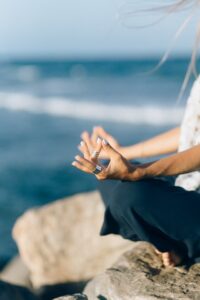 Through meditation we can get underneath each successive layer of illusory self, sometimes by negating (neti-neti) – “I am not this; I am not that,” – and sometimes by simply knowing that anything transient (thoughts, feelings, sensations, perceptions, memory, and imagination) is not us. This is what the Yogis call jnana – a knowingness of Self and non-self, a right discrimination between reality and illusion. When we sit quietly, and it may take some time to develop*, we have a greater ability to dive to the depths of our being, that simple yet refined essence, which is buried beneath the increasing layers of complexity, diversity and baggage that many call the ego.
Through meditation we can get underneath each successive layer of illusory self, sometimes by negating (neti-neti) – “I am not this; I am not that,” – and sometimes by simply knowing that anything transient (thoughts, feelings, sensations, perceptions, memory, and imagination) is not us. This is what the Yogis call jnana – a knowingness of Self and non-self, a right discrimination between reality and illusion. When we sit quietly, and it may take some time to develop*, we have a greater ability to dive to the depths of our being, that simple yet refined essence, which is buried beneath the increasing layers of complexity, diversity and baggage that many call the ego.
(*This is why I recommend dedicating oneself to learning and practicing means of Self-realization, uncovering one’s purpose and living by service and duty, and constantly discerning between truth and illusion through right knowledge [some call it rationality, some call it intuition, but it is both, together])
The ego makes up our individuality, and thus, our sense of separateness from others; essentially it is responsible for the many-ness that populates the world. But the oneness which universally and eternally underlies all individuals making up the many at every level of existence is what the great teachers of history have referred to when they have said we are all one. We ARE all one …in essence. Our cells make up our organs, which make up our bodies. From the many to one. Our thoughts make up our personas, which make up our personalities. From the many to one. To understand this, and to use this knowledge to detach from the individual elements that we generally mistake for ourselves, is the true goal of meditation, and ultimately of Yoga. When the individual quiets the brain noise by focusing on the usual elements of illusion, labels them, acknowledges their transient nature, and negates them as Self, they start to merge with, and are engulfed by, an indescribable experience (not quite feeling, not quite conception) of oneness (which is both nothingness and everythingness in paradoxical synchronicity).
 Over time, the ability to drop beneath the layers of consciousness allows the true Self to become aware of itself in every interaction and every dynamic. The Self recognizes it is the source of every experience, every relationship, and every sense of meaning. The Self knows that bliss is born of perception and attitude, which can be changed, and not the desires (and fears) typically inflicted upon consciousness. Replacing the self-love of the individual with love of the Self – the essence common to all things – changes our experience: desires are left unpursued, fears are discarded, and pleasures and pains are recognized as inextricably linked in space and time. By attuning to the Self, life can unfold spontaneously, without the pressure of needing this or that to happen. What is required is to simply discard the notion of individuation based on the transient elements of body, mind, and emotion, and to attune to what lies beneath them, and beneath consciousness itself. The essence of our authentic selves is what is common to all people. It is a pure awareness, in pure neutrality, bathed in unconditional love and appreciation for all things. Until we can look beyond the seeming many-ness of material individuation and attune to our underlying oneness, we will forever obsess over differences which separate us in the illusion we call “being ourselves.”
Over time, the ability to drop beneath the layers of consciousness allows the true Self to become aware of itself in every interaction and every dynamic. The Self recognizes it is the source of every experience, every relationship, and every sense of meaning. The Self knows that bliss is born of perception and attitude, which can be changed, and not the desires (and fears) typically inflicted upon consciousness. Replacing the self-love of the individual with love of the Self – the essence common to all things – changes our experience: desires are left unpursued, fears are discarded, and pleasures and pains are recognized as inextricably linked in space and time. By attuning to the Self, life can unfold spontaneously, without the pressure of needing this or that to happen. What is required is to simply discard the notion of individuation based on the transient elements of body, mind, and emotion, and to attune to what lies beneath them, and beneath consciousness itself. The essence of our authentic selves is what is common to all people. It is a pure awareness, in pure neutrality, bathed in unconditional love and appreciation for all things. Until we can look beyond the seeming many-ness of material individuation and attune to our underlying oneness, we will forever obsess over differences which separate us in the illusion we call “being ourselves.”



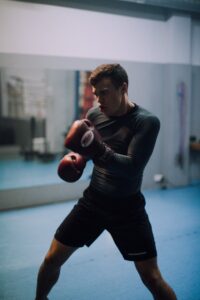
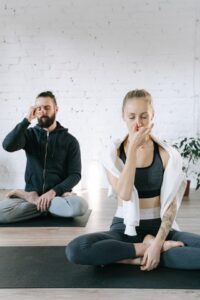


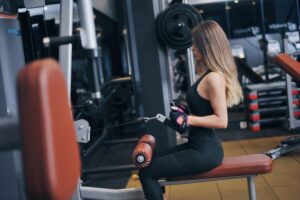

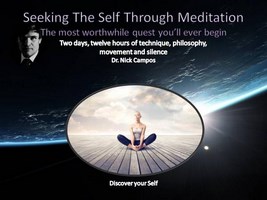

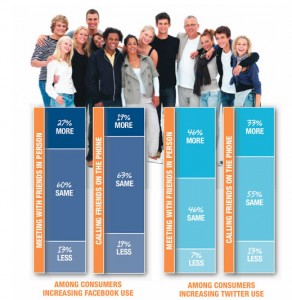

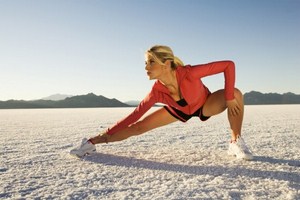 A common misconception people have about stretching is that it is a passive activity–that is, the muscles should be stretched by using of gravity to pull the muscles. Wrong! In fact, over time
A common misconception people have about stretching is that it is a passive activity–that is, the muscles should be stretched by using of gravity to pull the muscles. Wrong! In fact, over time 


